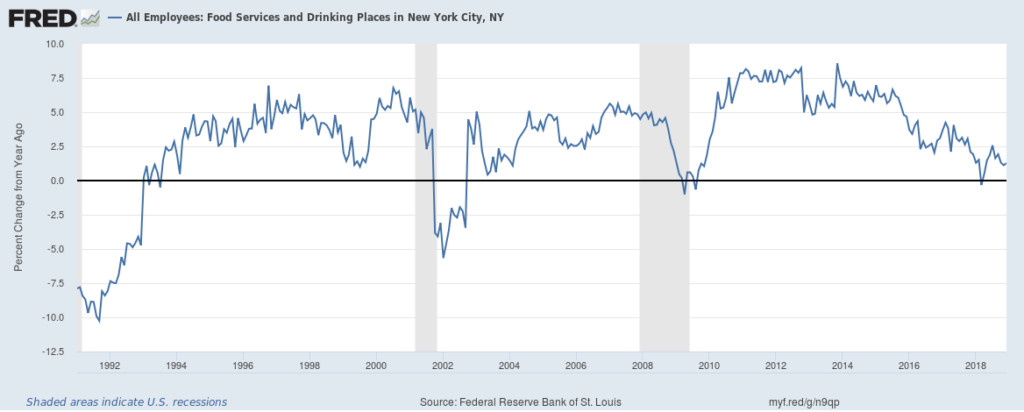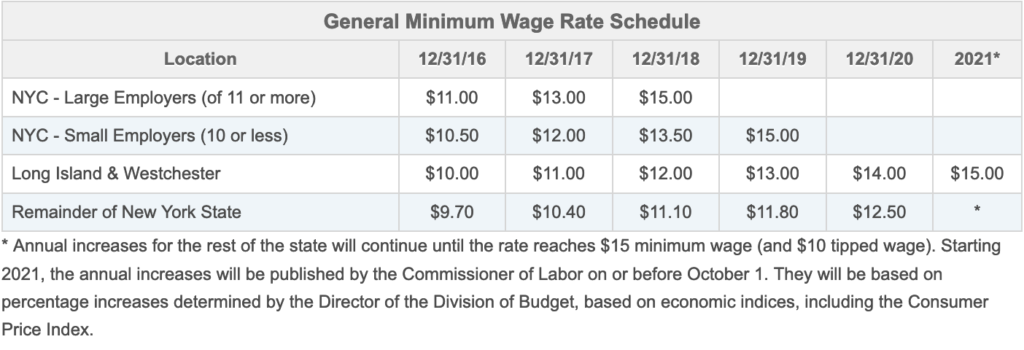@TBPInvictus here:
With his typical mendacity, and by cherry picking his data for unsuspecting readers, Mark Perry has again muddied the waters on minimum wage.
Perry begins his post with a dire chart showing the year-over-year percent change in employment for NYC’s full-service restaurants. He even provides a link to FRED, the St. Louis Fed’s data repository, so interested readers can follow along. It all seems straightforward and simple enough. But you have to be steeped in the nuances of this type of data to catch the con, which is this: “Full-service” is but one of eight categories of food service establishments covered by the Census. Here are all of them:
In fact, in New York City, full-service restaurant employees have never been more than 57% of all food services employees, and currently represent only about 53%.
So, why the focus on them?
Well, two reasons:
For one, Perry’s post cites a survey by the management-friendly New York City Hospitality Alliance, which claims that “75% of the more than 300 respondents operating full-service restaurants reported they’ll reduce employee hours this year because of the new wage increases, while 47% said they’ll eliminate jobs in 2019.” (For the record, the BLS’s Quarterly Census of Employment and Wages (QCEW) tallies over 10,000 eateries at the end of 2017 – in Manhattan alone. So I’m not sure how heavily I’d lean on an agenda-heavy survey of 300 restaurateurs.)
More to the point, however, is the fact that the most comprehensive, most inclusive data set – All Employees in Food Services & Drinking Places in NYC – doesn’t look nearly as dire as the one Perry used:
The series peaked at an unsustainable 8.5% year over year growth in November 2013, and has been declining since. I’d point out that, as with Seattle, there are lots of moving parts when it comes to analyzing any industry, restaurants included. Rents and saturation (eateries per capita) come immediately to mind. As this story points out:
“The top six metropolitan areas on this indicator are San Francisco, New York, Providence, Boston, Seattle and Portland,” writes Cortright. “Each of these cities has twenty or more restaurants per 10,000 population.”
There comes a saturation point in the number of per capita eateries any location can support. And we probably don’t even need to get into rents.
For reference, here is the law in NY relating to the minimum wage:
For future reference, here’s the tip off that Perry is trying to deceive or mislead you: You see something with his byline. That’s it. Easy peasy.
Finally, keep in mind that there is a growing body of evidence that a higher minimum wage simply does not do the damage its critics allege. The most recent contribution to that assessment is here.
~~~
BR here:
"New York City’s full-service restaurants are experiencing following the December 31, 2018 hike in the city’s minimum wage to $15 an hour"https://t.co/a1eizNoQt4
Please help me understand the a priori causation here… @Mark_J_Perry pic.twitter.com/zXjXVAl4xQ
— Barry Ritholtz (@ritholtz) March 4, 2019





